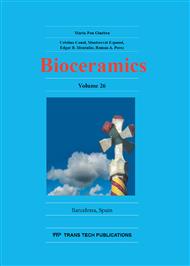p.99
p.107
p.113
p.119
p.128
p.137
p.143
p.151
p.156
Effect of Particle Size on Carbonate Apatite Cement Properties Consisting of Calcite (or Vaterite) and Dicalcium Phosphate Anhydrous
Abstract:
Calcium carbonate (CaCO3) has been known as one of the components of carbonate apatite (CO3Ap) cement. Calcite is one of the polymorph of CaCO3 with big particle size and excellent stability. In contrast, vaterite has small particle size and a metastable phase. To discover the effect of particle size on the properties of CO3Ap cement, this study investigated the different particle size of vaterite; calcite from vaterite, which has almost similar particle size and shape with vaterite; grounded calcite and ungrounded calcite. The powder phase of calcite or vaterite combined with dicalcium phosphate anhydrous (DCPA) was mixed with 0.8 mol/L of Na2HPO4 solution in 0.45 liquid to powder ratio. The paste was packed into a split stainless steel mold, covered with glass slide and kept at 37°C and 100% relative humidity for a period of time. XRD and FT-IR analysis revealed that CO3Ap cement consisted of vaterite and DCPA transformed to pure B-type CO3Ap in 72 hours while CO3Ap cement that consisted of calcite with different particle size was not completely transformed to CO3Ap even until 240 hours. We concluded that CO3Ap cement consisted of vaterite with small particle size and metastable phase properties is more effective as starting material due to its fast transformation to CO3Ap.
Info:
Periodical:
Pages:
128-133
Citation:
Online since:
November 2014
Authors:
Price:
Сopyright:
© 2015 Trans Tech Publications Ltd. All Rights Reserved
Share:
Citation:


